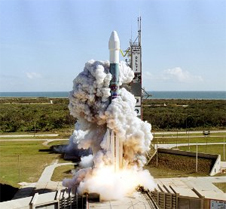January 29, 2010 Vol. 3, Issue 1
Five years ago Deep Impact launched to become the first mission to see beneath a comets surface.
Prior to Deep Impact, little was known about the interior of comets. Composed of dust, gas, and ice, comets contain 4.5 billion year-old ingredients left over from the beginning of the solar system. Scientists reasoned that understanding the inner makings of comets may help us understand the formation and evolution of our solar system, giving rise to the six-year Deep Impact mission.
On January 12, 2005, Deep Impact took off. The two-part spacecraft launched on a Delta II rocket and embarked upon an 83-million-mile collision course to Tempel 1, a comet 45 square miles in size.

Launch of Deep Impact spacecraft from Launch Pad 17B, Cape Canaveral Air Force Station, FL. Photo Credit: NASA
Six months later, the Deep Impact spacecraft split into its two components: a 380 kg copper-tipped impactor and a flyby spacecraft. The impactor hurtled towards its demise while the flyby spacecraft maneuvered itself into prime viewing position of the impact 500km away. The impactor made contact 24 hours later on July 4, ejecting comet debris into space for the flyby spacecraft, equipped with a camera and spectrometer, to view and analyze.
The images and data collected by the mission make up the most detailed data we have to date on comets. Within the comet, scientists found substances such as ice and organic compounds like carbonates and aromatic hydrocarbons originating from the part of the solar system occupied by Neptune and Uranus. Understanding the comet’s composition has helped scientists better understand how water and other organic compounds could have arrived on Earth.
The Deep Impact mission was the eighth of the low-cost Discovery missions. The spacecraft was designed and built by Ball Aerospace & Technologies Corporation, managed by the Jet Propulsion Lab, and the science was performed by the University of Maryland.
Tempel 1 was first discovered by Wilhelm Ernst Tempel in 1867, and orbits the Sun every five and a half years. Inspiration for Deep Impact came from studies on Halleys Comet in the late 1970s, which showed the comet to be blacker than previously thought.





